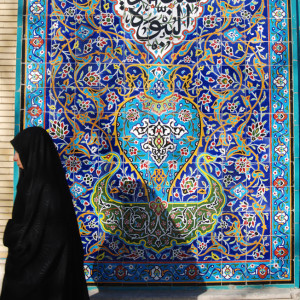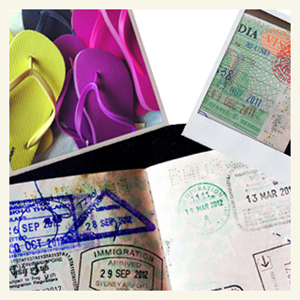MT. DESERT ISLAND, MAINE — A charming smile helps, when trying to get onto a lobster boat. That, and a bottle of Jack Daniel’s. This winning combination is how I found myself on the Linda Sea out on the Atlantic one fine September day, clumsily trying to put elastic bands on lobsters. I’m sure John would have taken me out on his boat without the bribe of whiskey — a testament to just how charming my smile is, or rather, the good nature of the people of Mt. Desert Island. He appreciated the gift all the same.
The gloves I wore were three sizes too big — like Mickey Mouse hands — and the insides were slippery with lanolin to shield the skin from corrosive salt water. In one hand I held the banding tool, what looked like a pair of pliers loaded with an elastic stretched over its flat tips. I gingerly picked up the two-pound beast, wary of the front claws that could easily break my finger. Its beady black eyes threw insults at me. If looks could kill. I puckered my lips and leaned in close as if going in for a kiss.
I wasn’t being romantic. I blew at it sharply and the lobster reflexively retreated, closing its claw shut, and I seized the opportunity to slide the band over the claw. It was a trick that John taught me.
I went to Mt. Desert Island, a 280-square-kilometre mountainous swath of nature off the coast of Maine, to hike and kayak. Yet I had spent the last four days doing little of that — unless you consider chewing an exercise. The trees and mountains, the lakes and lighthouses were glorious ’n all but I discovered there were earthly pleasures to be had. Bar Harbor, a pretty little town on the eastern shore, was a foodie heaven. Everything was fresh, plucked straight from Maine’s own good earth and sea, and the eateries — from seafood shacks to fine dining — all took pride in the local bounty. In a gluttonous rampage I indulged and indulged until I could no longer button up my hiking pants and my walk became a waddle.
 The star, of course, was lobster, the ubiquitous symbol of Maine. As I tucked into yet another grilled lobster tail lashed with butter, I thought of how important the creatures were to this place and its people, I thought of the depths of the waters from which they came and resolved to see it harvested from the sea.
The star, of course, was lobster, the ubiquitous symbol of Maine. As I tucked into yet another grilled lobster tail lashed with butter, I thought of how important the creatures were to this place and its people, I thought of the depths of the waters from which they came and resolved to see it harvested from the sea.
Two, sometimes three ships dropped anchor at Bar Harbor every day. Hundreds of voracious visitors flooded in daily, and the onslaught would not stop until the last autumn leaves had fallen. Still, the locals remained cheerful and buoyant and kind. To a hardened Torontonian, it was a reminder of how merciless we are with each other in the big city. It was this small-town friendliness that helped me find a lobsterman willing to take me on for a day.
The Bar Harbor waitress who served me my wild blueberry pancakes suggested I go down to the water. There, Freddy told me to try Southwest Harbor. At Southwest Harbor, Dennis gave me telephone numbers of lobstermen. A woman let me use her phone. John answered.
John stood at the helm tall and sturdy. The deep furrows on his weathered neck told a story of countless days in sun or sleet. He pushed the throttle forward, the engine grumbled then whirred and the Linda Sea bounded through the waves, spray slapping the boat and kissing my cheeks; I could taste the salt.
A thrill came over me as he pointed out his buoys bobbing in the water. Each lobsterman’s buoy was unique, the particular colour and striping registered. John’s were orange with a single black stripe. For me, it was like locating the “X” from a treasure map. In a flash John had hooked the buoy, pulled up the rope and fed it into a motorized roller that hauled the heavy traps all the way from the ocean floor.
One lobster was too small (John showed me how to measure it) and by law it could not be taken. Another was too large. We caught a female carrying her dark green roe on her belly. She also had to be tossed back, but not before John made a V-shaped notch on her tail to let others know she was capable of bearing eggs and, therefore, could not be taken. When we finally did find what I called the “Goldilocks lobsters” — not too small or too large but just right — John set them in the bin and banded them.
We didn’t do much personal talk. I knew he had a wife and no children. His nephew was also a lobsterman. The most surprising fact about him was that he was a part-time pharmacist, retired now, though he picked up the odd shift every now and again. I had trouble imagining that this man standing in front of me stuffing bait bags full of bloody herring also stood behind a counter carefully doling out pills.
In the dying light of day, as the boat headed home toward the rugged line of the coast, I finally acknowledged the truth: I could never understand what it was like to be dependent on nature. To a Torontonian, the concept of tides meant nothing to me. Neither did fog or winds, the politics of a harbour or rules of fishing the seas. The deep relationship John had with the ocean was foreign to me.
Through him, though, I learned a thing or two about those lobsters.
At first I thought they were hideous, like freaky giant bugs of the deep. Yet, during the course of the day, I began to see the beauty in nature’s design — the symmetry, the elegant tail, even the absurdly strong claws that I was so fearful of were to be admired. And so was the colour of its armour, something worth puckering up to and leaning in closely to view: deep burgundy, sleek black and, if you were lucky, vivid Cerulean blue.
This story was published in The Toronto Star on September 8, 2011.
You might also like


Pingback: 10 reasons to love Bern | So Many Miles()